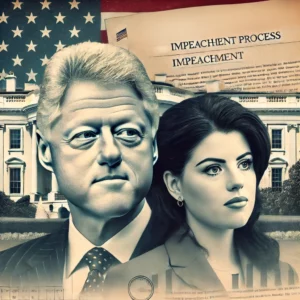The Lewinsky scandal brought to light an extramarital affair between President Bill Clinton and White House intern Monica Lewinsky, leading to charges of perjury and obstruction of justice. The scandal culminated in Clinton’s impeachment by the House of Representatives, marking a pivotal moment in American political history.
The Affair and Investigation
In early 1998, the news broke of President Clinton’s affair with Monica Lewinsky, a White House intern. The relationship, which took place between 1995 and 1997, involved several encounters in the White House. When the scandal first emerged, Clinton vehemently denied the allegations under oath, famously stating, “I did not have sexual relations with that woman, Miss Lewinsky.” However, Lewinsky’s detailed accounts, corroborated by physical evidence, including the infamous blue dress with Clinton’s DNA, contradicted his statements.
Independent Counsel Kenneth Starr, who was already investigating Clinton on other matters, expanded his inquiry to include the Lewinsky affair. The Starr Report, submitted to Congress in September 1998, detailed the affair and accused Clinton of perjury and obstruction of justice.
Impeachment Process
The House of Representatives impeached President Clinton on December 19, 1998, on two charges: perjury to a grand jury and obstruction of justice. The impeachment marked the first time in over a century that a sitting U.S. president had been impeached, the previous instance being President Andrew Johnson in 1868.
The Senate trial commenced in January 1999. The prosecution, led by House managers, argued that Clinton’s actions had undermined the integrity of the office of the president and the rule of law. They presented evidence of Clinton’s attempts to cover up the affair and to persuade others to lie on his behalf. The defense team countered by arguing that while Clinton’s behavior was inappropriate, it did not constitute high crimes and misdemeanors warranting removal from office.
Outcome
On February 12, 1999, the Senate voted to acquit President Clinton on both charges. The vote on perjury was 45 guilty to 55 not guilty, while the vote on obstruction of justice was 50 guilty to 50 not guilty. Both fell short of the two-thirds majority required for conviction and removal from office. Clinton completed his term in office, leaving the presidency in January 2001.
Despite the scandal and impeachment, Clinton’s approval ratings remained high. Many Americans viewed the impeachment as politically motivated and believed that Clinton’s personal indiscretions did not warrant his removal from office. Clinton went on to have a significant post-presidency career, continuing to influence both domestic and international affairs.

The Lewinsky scandal and the subsequent impeachment of Bill Clinton were defining moments in late 20th-century American politics. The events underscored the intense scrutiny faced by public officials and sparked an ongoing debate about the boundaries between private conduct and public responsibility. Despite the controversy, Clinton’s resilience and continued popularity highlight the complex nature of political scandals and public perception.
